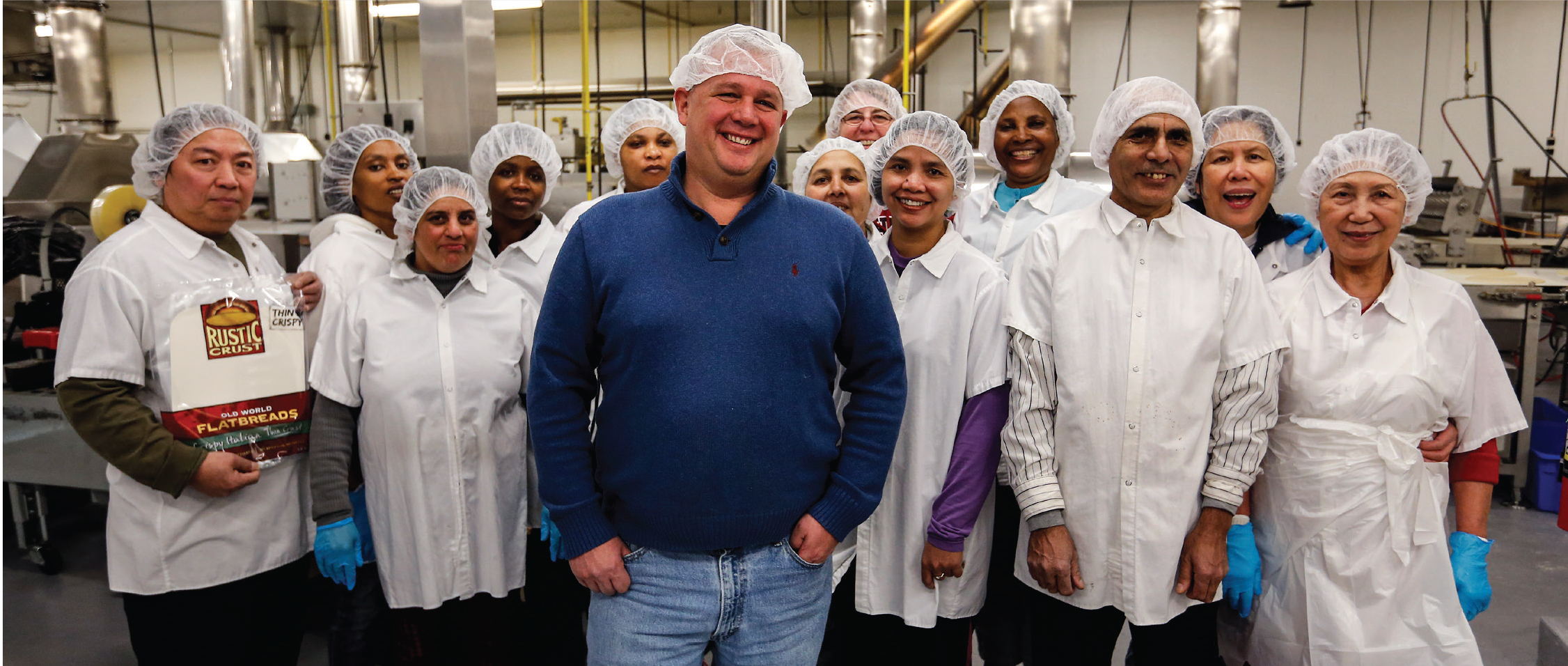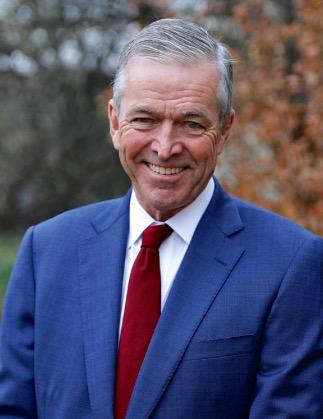Daily Yonder: Rural Investments Could Be the Next ‘Big Opportunity,’ Former USDA Official Says

Rustic Crust CEO Brad Sterl is flanked by employees at their New Hampshire production facility. The company benefited from an $8 million investment spurred by a USDA initiative. (Photo by Cheryl Senter via New Hampshire Charitable Foundation, which also supported the company’s expansion through its New Hampshire Community Loan Fund.)
by Sarah Mock | January 9, 2019
Rural America’s slow recovery from the Great Recession isn’t entirely bad news, says the founder of the Rural Opportunity Initiative. For smart public and private investors, it could provide a chance to get ahead of the pack.
There’s not much grass on Georgetown University’s Washington, D.C., campus, let alone farms, forests, or open land. But the school’s Rural Opportunity Initiative still hopes to be a gateway for rural communities to gain access to the public and private resources of the nation’s capital.
The initiative’s executive-in-residence, Matt McKenna, is focused on getting investment dollars into America’s heartland. McKenna founded the initiative when he left the USDA in 2016, as a way to carry on the work he’d started as an advisor to the department’s Obama-era Rural Development programs. He focused mainly on building public-private partnerships, bringing together rural entrepreneurs and the capital they needed to grow.
Rural companies and entrepreneurs in the U.S. share many similarities and common challenges with those in the developing world, McKenna says, a fact that made Georgetown, with its global economic development focus, a natural home for the initiative. One of those common challenges? That decades after the Great Recession, rural places continue to struggle to invigorate their economies. But the slow pace of rural recovery could actually be a positive marker of potential for investors, McKenna said.“Banks view that as an opportunity, not a deficit,” he said. “An opportunity to be the people on the ground to make the first buck, to make the first investments.”
The main barrier to participating in rural investment is scale, McKenna says. For example, providing financing for a community water infrastructure project could lead to years, even decades of steady returns. But such a project might only require $2-3 million. Big banks and venture funds are looking for projects more on the scale of $50 million, if not $500 million or $5 billion.
McKenna says finding a way to bundle smaller deals into a large and diverse package could be a powerful way to get big funders to participate in the space. For organizations looking to spur rural economic development, building those pathways for investment should be a priority. And the U.S. Department of Agriculture could lead the way.
In 2012, USDA’s loan portfolio included over one million home, business, and public utility loans totaling around $212 billion, giving it a portfolio in the ballpark of some of America’s biggest banks. Former Secretary of Agriculture Tom Vilsack explained at the recent Rural Investment Forum, an event hosted at Georgetown by the Rural Opportunity Initiative, that the USDA can take a primary role in illustrating how to make rural capital investments pay.
“You’ve got to build the pathway,” Vilsack said in his address. “The private sector has money to invest… whether that’s in broadband, hospital systems, water systems, venture capital, simply lending money. The private sector is well familiar with how to flex their muscle. But there’s a lack of awareness of those opportunities.”
USDA is also using their Rural Business Investment Program to entice capital to America’s countryside, a program that requires venture funds to invest 75% of their capital in rural communities. One of the earliest participants, Advantage Capital Agribusiness Partners, raised $150 million to invest in rural projects, including an $8 million investment in rural New Hampshire pizza company Rustic Crust, Inc. in 2018. Vilsack praised these programs for creating awareness of opportunities beyond coastal metros among institutional investors.
Another explanation for lack of investor awareness is that rural entrepreneurs aren’t always “investment ready.” Emily Edwards, a product manager at Village Capital, which finds, trains, and invests in overlooked entrepreneurs, including those that are geographically overlooked, says that rural entrepreneurs set themselves apart from those in cities. They should take advantage of those selling points, she said.
“Rural entrepreneurs tend to have more lived experiences,” she said. “They’re trying to solve problems they’ve lived through. But that doesn’t always make them good at talking to investors.”
Edwards, who spoke on the forum’s human capital panel, said that the lack of awareness occurs on both sides, as rural entrepreneurs often don’t know who to talk to about capital, nor when they need it, how to get it, or even how much they need. Her work at Village Capital involves education, training, and networking for entrepreneurs that helps them learn how to answer those questions.
Stakeholders at the forum discussed strategies for attracting major investment dollars through federal, state, and local partnerships, as well as how to take advantage of recently finalized “opportunity zones.” These zones, designated by the Department of the Treasury and the IRS are areas where companies will receive special incentives and tax breaks over the next 10 years when they invest there. On the current map of opportunity zones, about 40% are low-density rural areas, they’re home to about 12 million people, and are present in all 50 states and US territories.
Attendees also considered whether it would be equally as effective to attract major corporations, like a second Amazon headquarters or a Tesla factory, to rural places. Though these moves would certainly bring jobs, McKenna says, they’re extremely rare. Since small businesses are still the number one source of new jobs in the US, providing capital is a more meaningful source of long term growth.
The Rural Opportunity Initiative is taking the discussion of rural investment beyond Washington, D.C., as well, through its partnerships with Perdue, Iowa State, and Mississippi State universities. They expect to continue their work of connecting investors directly with rural entrepreneurs in 2019 and beyond.

